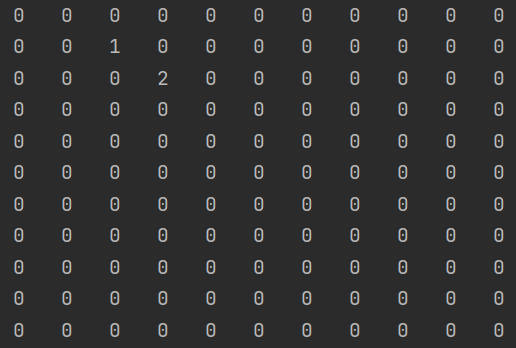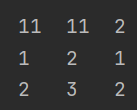编写的五子棋程序中,有存盘退出和续上盘的功能。

因为该二维数组的很多值是默认值0, 因此记录了很多没有意义的数据==》稀疏数组
当一个数组中大部分元素为0,或者无效数据数量远大于有效数据数量,可以使用稀疏数组来保存该数组,以减少存储空间。
把具有不同值的元素的行列及值记录在一个小规模的数组中,从而缩小程序的规模
原二维数组 
稀疏数组

第一行:11(有11行数据)11(有11列数据)2(不同的值有两个)
第二行:1(有效值在第二行)2(有效值在第3列)1(值是1),以此类推
使用稀疏数组,来保留类似前面的二维数组(棋盘、地图等等)
把稀疏数组存盘,并且可以从新恢复原来的二维数组数

public static void main(String[] args) throws Exception {
//创建一个二维数组
//0代表没有数据,1代表黑子,2代表白子
int[][] chessArray1 = new int[11][11];
chessArray1[1][2]=1;
chessArray1[2][3]=2;
//输出原始的二维数组
for (int[] row : chessArray1){
for(int item : row){
System.out.printf("%d\t", item);
}
System.out.println();
}
//将二维数组转化为稀疏数组
//1. 循环遍历二维数组,得到有效数据的个数
int sum = 0;
for (int i = 0; i < chessArray1.length; i++){
for (int j = 0; j < chessArray1[i].length; j++){
if(chessArray1[i][j] != 0){
sum++;
}
}
}
System.out.println("sum = " + sum);
//2. 创建稀疏数组
//赋值
int[][] sparseArray = new int[sum + 1][3];
sparseArray[0][0] = 11;
sparseArray[0][1] = 11;
sparseArray[0][2] = sum;
//遍历二维数组,将有效数组放到sparseArray中
int count = 0;
for (int i = 0; i < chessArray1.length; i++){
for (int j = 0; j < chessArray1[i].length; j++){
if(chessArray1[i][j] != 0){
count++;
sparseArray[count][0] = i;
sparseArray[count][1] = j;
sparseArray[count][2] = chessArray1[i][j];
}
}
}
//输出得到的稀疏数组
for (int[] row : sparseArray){
for(int item : row){
System.out.printf("%d\t", item);
}
System.out.println();
}
//将二维数组存储到磁盘的文件上
String path = "E:\\java\\idea\\place\\DataStructure/info.txt";
FileWriter fileWriter=null;
File file = new File(path);
try {
fileWriter= new FileWriter(file);
for (int[] array : sparseArray) {
fileWriter.write(array[0]+"\t"+array[1]+"\t"+array[2]);
fileWriter.write("\r\n");
}
}catch (Exception e){
e.printStackTrace();
}finally {
try {
if(fileWriter != null){
fileWriter.close();
}
}catch (Exception e){
e.printStackTrace();
}
}
int[][] sparseArray2=null;
boolean isNotRead=false;
BufferedReader bufferedReader;
bufferedReader=new BufferedReader(new FileReader(file));
String lineStr;
int curCount=0;
while ((lineStr=bufferedReader.readLine())!=null){
String[] tempStr=lineStr.split("\t");
if(!isNotRead){
sparseArray2=new int[Integer.parseInt(tempStr[2])+1][3];
sparseArray2[curCount][0]=Integer.parseInt(tempStr[0]);
sparseArray2[curCount][1]=Integer.parseInt(tempStr[1]);
sparseArray2[curCount][2]=Integer.parseInt(tempStr[2]);
curCount++;
isNotRead=true;
}else {
sparseArray2[curCount][0]=Integer.parseInt(tempStr[0]);
sparseArray2[curCount][1]=Integer.parseInt(tempStr[1]);
sparseArray2[curCount][2]=Integer.parseInt(tempStr[2]);
curCount++;
}
}
bufferedReader.close();
System.out.println("==================");
assert sparseArray2 != null;
for (int[] row : sparseArray2){
for(int item : row){
System.out.printf("%d\t", item);
}
System.out.println();
}
System.out.println("==================");
//将稀疏数组转化为二维数组
int[][] chessArray2 = new int[sparseArray[0][0]][sparseArray[0][1]];
for(int i = 1; i < sparseArray.length; i++){
chessArray2[sparseArray[i][0]][sparseArray[i][1]] = sparseArray[i][2];
}
//输出二维数组
for (int[] row : chessArray2){
for(int item : row){
System.out.printf("%d\t", item);
}
System.out.println();
}
}
原文:https://www.cnblogs.com/ftlzypx/p/15059145.html